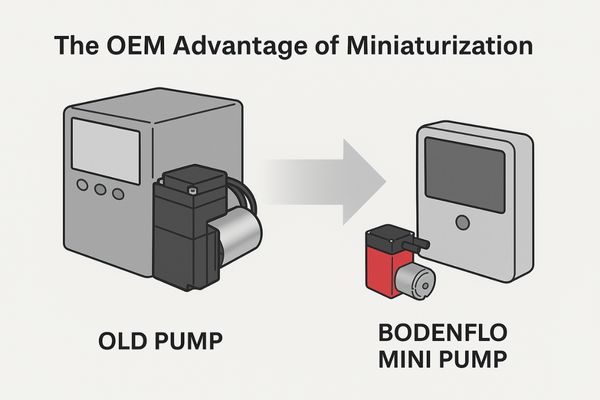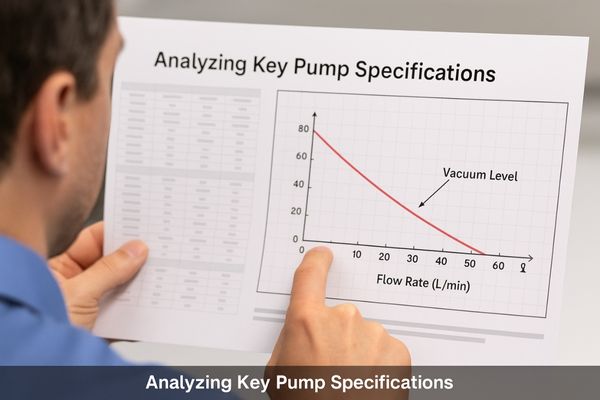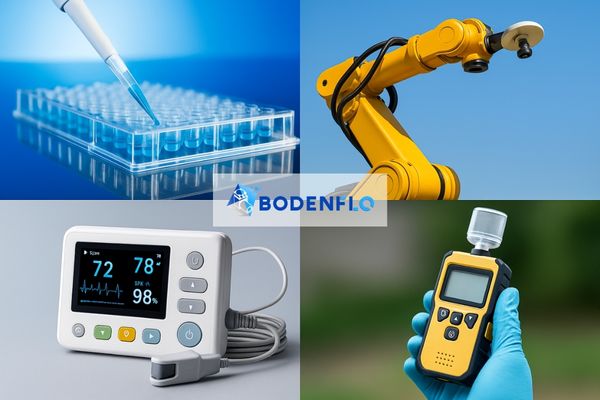As an OEM, every component choice feels like a high-stakes decision. Selecting a bulky, power-hungry, or unreliable suction pump can compromise your entire product design, leading to costly overhauls.
A negative pressure pump, also known as a vacuum or suction pump, creates a pressure lower than the surrounding atmosphere to draw in fluids or hold objects. For OEMs, it is a critical component that enables miniaturization, precision control, and new functionalities in advanced devices.

From my perspective as a product manager at BODENFLO, the miniature negative pressure pump is one of the most transformative components in modern engineering. I once worked with an OEM developing a portable blood analyzer. Their initial prototype used a large, off-the-shelf pump that made the device heavy and loud, with a short battery life. They were on the verge of scrapping the "portable" concept altogether. I introduced them to one of our miniature diaphragm pumps. The change was immediate. The final product was 40% smaller, whisper-quiet, and ran for hours on a single charge. This experience proved to me that the right pump isn’t just a part; it’s an enabler that can define the success and market competitiveness of an OEM product.
How Does a Negative Pressure Pump Actually Create Suction?
Your design requires consistent suction, but the physics can seem complicated. Picking a pump without understanding the core principle can lead to weak performance and system failure right from the start.
A negative pressure pump creates suction by using a mechanical action, like moving a diaphragm, to expand the volume of a sealed chamber. This expansion lowers the pressure inside the chamber relative to the outside atmosphere, forcing fluid or air to be pushed in.
The simplest way I explain this to clients is by telling them to think about drinking from a straw. You’re not actually "sucking" the liquid up. You are expanding your cheeks to create a low-pressure zone in your mouth, and the higher atmospheric pressure outside pushes the liquid up the straw for you. Our miniature diaphragm pumps do exactly this, but in a controlled, motorized way.
A motor drives an eccentric that pulls a diaphragm back, increasing the chamber volume and creating a vacuum. The higher pressure outside pushes air or liquid into the pump’s inlet. This simple, reliable mechanism is the engine behind countless precision tasks, from sampling air for environmental analysis to handling delicate silicon wafers in a cleanroom.
The Principle of Pressure Differential1
The pump doesn’t "pull"; it creates a low-pressure condition that allows the higher atmospheric pressure to "push" fluid into the system. The effectiveness of this is measured by the vacuum level, typically in negative kilopascals (-kPa).
Key Components in Action
- Motor: Provides the power (typically a brushed or brushless DC motor).
- Eccentric: Converts the motor’s rotation into linear motion.
- Diaphragm: A flexible membrane that seals the pump chamber. As it pulls back, it creates the vacuum.
- Valves: Check valves ensure fluid flows in one direction—in through the inlet and out through the exhaust.
| Component | Function | Impact on OEM Design |
|---|---|---|
| Motor Type | Drives the pump | Determines lifespan, power consumption, and cost. |
| Diaphragm Material | Creates the seal | Critical for chemical compatibility with the fluid. |
| Chamber Volume | Defines displacement | Affects flow rate and the physical size of the pump. |
Why is Choosing the Right Suction Pump a Game-Changer for OEMs?
As an OEM, every component affects your product’s performance, cost, and reputation. A poorly chosen pump can lead to field failures, bloated designs, and unhappy customers, directly impacting your bottom line.
The right miniature suction pump is a strategic advantage. It allows OEMs to build smaller, lighter, and more reliable products. This translates to a better user experience, lower warranty costs, and a stronger competitive position in the market.

I consistently see three major wins for OEMs who select a high-quality miniature pump. First is miniaturization2. A medical tech client was able to develop a wearable therapy device only because our pump weighed under 30 grams. Second is reliability. For an OEM in the robotics space, their pick-and-place machine’s uptime is everything.
Using one of our 10,000-hour brushless pumps meant their customers had fewer service calls and less production downtime. Finally, it’s about the total cost of ownership (TCO)3. Another client initially balked at the higher price of a brushless pump but quickly realized that avoiding a single field replacement more than paid for the difference. For an OEM, the pump’s cost is a small part of the equation; the cost of its failure is enormous.
Pillars of OEM Success
- Performance & Precision: A consistent vacuum is non-negotiable for applications like medical aspiration or gas sampling.
- Reliability & Lifespan: The pump’s lifespan must match the product’s expected life to protect brand reputation.
- Integration & Footprint: A compact, lightweight pump simplifies design, reduces material costs, and enables portability.
| OEM Concern | How the Right Pump Provides a Solution |
|---|---|
| Product Size/Weight | Miniature pumps (as light as 18g) enable handheld and wearable designs. |
| Warranty Claims | High-lifespan brushless motors (3,000-10,000+ hours) drastically reduce field failures. |
| Power Consumption | Efficient low-voltage DC motors extend the battery life of portable devices. |
| Product Differentiation | A quiet, reliable pump improves the end-user experience, setting the product apart. |
What Key Pump Specifications Should an OEM Never Ignore?
Are you drowning in datasheets filled with numbers? Focusing on the wrong specification for your application can lead to a pump that’s too weak, too slow, or drains your battery instantly.
An OEM must prioritize three key specs: vacuum level (-kPa) for suction strength, flow rate (L/min) for speed, and power consumption (V/A) for efficiency. Matching these to your application’s needs is the foundation of a successful design.

I always guide my clients to think of these specs in a simple way. Vacuum level4 is the strength of the suction. How hard can it pull? This is critical for holding objects or drawing samples through a filter. Flow rate5 is the speed. How quickly can it evacuate air from a container or pull a sample? For a client developing a rapid diagnostic device, high flow was essential to reduce test time. Power consumption is the efficiency. How much battery will it use? This is the most important spec for any portable or battery-operated device. Getting the balance right between these three is the secret. You must analyze the performance curve, which shows how flow rate changes as the vacuum level increases, to find the perfect operating point for your device.
The Big Three Specifications
- Vacuum Level (-kPa): The maximum suction force the pump can generate.
- Flow Rate (L/min): The volume of air the pump can move per minute at a given pressure.
- Power Consumption (V & A): The voltage and current required to operate the pump.
| Specification | What It Means in Practice | Why It Matters to an OEM |
|---|---|---|
| Vacuum Level | "Strength" – Can it hold the object? | Determines if the pump has enough force for the task. |
| Flow Rate | "Speed" – How fast can it clear the volume? | Impacts cycle time, test speed, and user experience. |
| Power Consumption | "Efficiency" – How long will the battery last? | Directly affects device portability and operational cost. |
Brushed vs. Brushless: Which Motor Is Right for Your OEM Product?
You’re facing a choice between a lower-cost brushed pump and a premium brushless one. This single decision could determine your product’s lifespan and your company’s reputation for quality and reliability.
The choice is clear: brushed motors are for low-cost, intermittent-use applications where a shorter lifespan is acceptable. Brushless motors are essential for any product requiring long-term reliability, continuous operation, low noise, and high efficiency.
I have this conversation with OEM clients almost every day. The motor is the heart of the pump, and its technology dictates the pump’s entire character. A brushed motor has physical carbon brushes that make contact to power the motor. They are simple and cheap, but they physically wear down over time, creating dust and eventually failing. They are perfect for a consumer device used a few minutes a day. A brushless motor uses electronics instead of brushes. There’s no physical wear, so they last drastically longer—often over 10,000 hours. They are also quieter and more efficient. For a medical device that runs for hours or an industrial robot operating 24/7, choosing a brushless pump isn’t a luxury; it’s a requirement to prevent costly downtime and product failure.
Head-to-Head Comparison
- Lifespan: The most significant difference. Brushless motors last 5-10 times longer.
- Cost: Brushed motors have a lower upfront cost, but brushless pumps often have a lower total cost of ownership due to superior reliability.
- Performance: Brushless motors are generally more efficient and produce less electromagnetic interference (EMI), which is critical for sensitive electronics.
| Feature | Brushed DC Motor Pump6 | Brushless DC (BLDC) Motor Pump |
|---|---|---|
| Lifespan | Lower (300 – 2,000 hours) | Much Higher (3,000 – 10,000+ hours) |
| Initial Cost | Lower | Higher |
| Reliability | Good | Excellent |
| Noise & EMI | Higher (due to sparking) | Lower |
| Best For | Intermittent use, cost-sensitive projects | Continuous use, medical, critical applications |
Which OEM Industries Depend Most on Negative Pressure Pumps?
You know you need suction for your application, but you’re unsure if a miniature pump is robust enough. This hesitation could cause you to overlook a component that would otherwise revolutionize your product.
From medical diagnostics to industrial automation, miniature negative pressure pumps are the hidden workhorses in today’s most demanding OEM applications. Their reliability and performance make them indispensable in fields where precision and portability are critical.

It’s amazing to see the sheer breadth of industries we serve. Just last week, I helped two very different clients. One was an OEM building environmental drones that fly into hazardous areas to sample air. They needed a pump that was extremely lightweight but could create a strong vacuum (-80 kPa) to pull samples through a filter. The other client was developing a high-end skincare device that uses vacuum suction7 for exfoliation.
They needed a pump that was not only small and powerful but also exceptionally quiet for a premium user experience. In both cases, the success of their entire product hinged on the specific performance characteristics of the miniature pump8. This shows that no matter the industry, the core requirements of reliability, precision, and compact size are universal.
Medical and Laboratory
These pumps are essential for drawing precise volumes of fluid in blood analyzers, DNA sequencing machines, and automated liquid handlers. They also power wound therapy devices and medical suction equipment.
Robotics and Automation
In manufacturing, suction pumps are used for "pick and place" robotic arms that handle delicate components like microchips, glass, and solar cells without causing damage.
Environmental Monitoring
Portable gas detectors and air quality samplers rely on these pumps to pull a consistent and known volume of air across a sensor for accurate analysis.
| Industry | Specific OEM Application | Critical Pump Requirement |
|---|---|---|
| Medical Devices | Portable blood analyzer | Precision, oil-free operation, reliability. |
| Robotics | Pick-and-place of silicon wafers | Stable vacuum, long lifespan for 24/7 operation. |
| Environmental | Handheld gas detector | Low power draw, lightweight, consistent flow. |
| Beauty & Skincare | Microdermabrasion device | Low noise, compact size, controlled suction. |
What Are the Most Common Mistakes OEMs Make When Selecting a Suction Pump?
It’s easy to make a mistake when sourcing components, but a mistake with your pump can be catastrophic. These errors lead to product failures, budget overruns, and painful last-minute redesigns.
The most common mistakes are focusing only on initial price instead of total cost, ignoring the product’s real-world operating environment, and underestimating the required duty cycle for the application.
I’ve seen these three mistakes sink more projects than any technical challenge. The first is price-obsession9. An OEM saved $5 per unit on a cheaper pump, but when 10% of their devices failed in the first year, the warranty and replacement costs wiped out their profits. The second mistake is ignoring the environment.
A pump that works perfectly in an air-conditioned lab at 22°C may fail when the device is used outdoors at 40°C in high humidity. You must test for the worst-case scenario. The third, and maybe most common mistake, is miscalculating the duty cycle. A client told me their device was for "intermittent use," so they chose a brushed pump. But their end-users were running it for 30 minutes straight, multiple times a day. The pumps burned out quickly because the application was much closer to continuous duty.
How to Avoid These Pitfalls
- Think TCO: Calculate the total cost of ownership, including potential warranty and replacement costs, not just the upfront price.
- Test in Reality: Test the pump in the harshest environmental conditions your product will face.
- Define Duty Cycle Honestly: Be realistic about how end-users will operate the device. If there’s any doubt, spec for a higher duty cycle.
| Common Mistake | The Correct Approach | Why It Matters |
|---|---|---|
| Focusing on Initial Price | Analyze the Total Cost of Ownership10 (TCO). | Reliability saves more money in the long run than a cheap component. |
| Ignoring Environment | Test for temperature, humidity, and vibration. | Environmental stress is a leading cause of premature failure. |
| Underestimating Duty Cycle | Design for real-world usage patterns. | Prevents burnout and ensures the pump meets its expected lifespan. |
Conclusion
A negative suction pressure pump is a foundational component for modern OEMs. Understanding its function and choosing the right model is a strategic decision that directly impacts product size, reliability, and market success.
At BODENFLO, we specialize in high-performance miniature pumps designed for medical, laboratory, automation, and environmental applications. Whether you need standard models or custom-engineered solutions, our pumps deliver oil-free, maintenance-free, and long-life performance that enables OEM innovation worldwide.
📩 Partner with BODENFLO today to power your next OEM breakthrough. Contact us at info@bodenpump.com
to discuss your requirements.
-
Understanding pressure differential is crucial for optimizing pump performance and efficiency. ↩
-
Explore how miniaturization enhances device functionality and user experience in medical technology. ↩
-
Understanding TCO can help OEMs make informed decisions that save money in the long run. ↩
-
Understanding vacuum level is crucial for optimizing suction strength in various applications. ↩
-
Exploring flow rate helps in enhancing efficiency and speed in diagnostic devices. ↩
-
Learn about the limitations of brushed motors, including lifespan and maintenance issues, to make informed decisions. ↩
-
Learn about the technology behind vacuum suction in skincare and its benefits for a premium user experience. ↩
-
Explore how miniature pumps are revolutionizing industries with their compact design and powerful performance. ↩
-
Understanding the pitfalls of price-obsession can help you make better purchasing decisions and avoid costly mistakes. ↩
-
Exploring TCO calculation methods can lead to smarter investments and long-term savings in your projects. ↩


